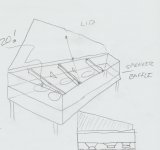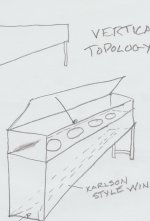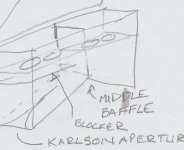Ahh, I see where you were going with that. Did you see my response/question about damping materials?
yes i did, damping isn't a blanket solution (pun intended) it's a question of what material vs which frequency your trying to attenuate and when it comes to resonances it sometimes a range of frequencies polyfill or wool which is better at mid to high frequency isn't going to fix an enclosure that's behaving like a cajong! that where braces and enclosure stiffness is the means to the end.
so long as you include an adjustable lid just like a grand!I've been thinking more now of trying this cab on its back, raised up like a grand piano, with the speakers facing up. If I try this, I would probably recess the front baffle into the cab 8" or so.
come to think of it mimicking a grand enclosure with non parallel sides would be less likely to develop resonances to begin with! i wish i had a cad program to show what i would try...The thinking here is to mimic the placement of the soundboard in a grand, and also to contain the sound a bit instead of them sitting right on top of everything. At that point I would try removing the rear panel to create a sort of contained open baffle (top/bottom/side panels would still be in place).
the way i see it it would/might be possible to reconfigure your enclosure to get just that!A dipole is an interesting idea here, but holy cow, I wouldn't know where to start with designing that, and how that would work out for the player position a the keyboard. That might be a bit too much to chew off, for this first project.
indeed!There are just SO many possibilities, and it will definitely take some time to test a variety of them, and get the baffling/dampening in place.
come to think of it mimicking a grand enclosure with non parallel sides would be less likely to develop resonances to begin with! i wish i had a cad program to show what i would try...
Its quite possible that a trapezoid shape would help that, but if I dont want to go redesigning the cab and taking the time to cut it correctly, I could probably break up the parallel walls with some angled boards inside, right?
What benefits would a dipole configuration give me if done properly? Reduction in resonances?the way i see it it would/might be possible to reconfigure your enclosure to get just that!
hope this works...
Wow I appreciate your enthusiasm for all this! Great drawings. Giving me more ideas that I wish I had thought of from the start! The thing I'm realizing with all this, is that as AllenB stated on page 2, this idea is really sound reproduction, not production, since the piano samples/sounds already produce the resonant tone of the piano body. My idea of having a resonant cabinet that would make a bigger more ambient sound is flawed. The real idea is to have speaker placement and design that produces less point source type sound. I'm realizing the cabinet needs to be free of resonances, as much as possible.could also go with a vertical topology and use a karlson aperture on the bottom side.
SO... I just need to evaluate where I'm at, and what I need to do to get it to where I want it. Bracing and damping materials are the first step, I believe. Next would be to adjust the plane of the mounting baffle. I feel like if I make a horizontal baffle with the drivers facing up, that might get a bit harsh sounding being so close to them pointing more towards you than how they are now, in the back. But if done right, it may not be. I could also add some sort of diffusion over top of them, maybe.
The Karlson aperture, is that to improve bass response?
I must have hidden my answer too well in my words. I don't know whether it is a bad thing. This is a time of creativity.Is this a good or bad thing?
In hifi sometimes a speaker sounds good, the cabinet is vibrating so it gets braced. Then it sounds bad. It can be very complicated to work out why and move to the next step. Some prefer to leave some cabinet vibration. They have developed a plan with the type of wood and the way they brace.
I feel like if I make a horizontal baffle with the drivers facing up, that might get a bit harsh sounding being so close to them pointing more towards you than how they are now, in the back. But if done right, it may not be. I could also add some sort of diffusion over top of them, maybe.
on axis response would get more of the high's that tend to beam directed towards you which is why i was suggesting the lid to act as a reflector and the lids position can be used as a mechanical low pass filter the same way it's used in a grand piano. i'm also the sort of heretic who would use a linear actuator to adjust the position via midi to accommodate response changes depending on what program i'm running, it is a digital keyboard after all!!
yes, but may not be necessary.... frequency shading across four drivers could be employed.The Karlson aperture, is that to improve bass response?
I must have hidden my answer too well in my words. I don't know whether it is a bad thing. This is a time of creativity.
In hifi sometimes a speaker sounds good, the cabinet is vibrating so it gets braced. Then it sounds bad. It can be very complicated to work out why and move to the next step. Some prefer to leave some cabinet vibration. They have developed a plan with the type of wood and the way they brace.
Understood. Time for some trial and error.
on axis response would get more of the high's that tend to beam directed towards you which is why i was suggesting the lid to act as a reflector and the lids position can be used as a mechanical low pass filter the same way it's used in a grand piano. i'm also the sort of heretic who would use a linear actuator to adjust the position via midi to accommodate response changes depending on what program i'm running, it is a digital keyboard after all!!
Hahaha now that's an idea. The lid would definitely help control the tone/brightness. I also wonder if some sort of mild diffusion panel/cover would also help smooth out any harshness.
I also wonder if some sort of mild diffusion panel/cover would also help smooth out any harshness.
that could be used to good effect, picture if you will (insert Twilight Zone intro music in background) using the two BG 20's per side and configuring them like a Nola Brio with one driver frequency shaded and the other running full range place a shaped reflector on the lid above the driver running fullrange and you have a mechanically adjustable stereo spreader....i think i need to have a scotch and do some contemplation....
that could be used to good effect, picture if you will (insert Twilight Zone intro music in background) using the two BG 20's per side and configuring them like a Nola Brio with one driver frequency shaded and the other running full range place a shaped reflector on the lid above the driver running fullrange and you have a mechanically adjustable stereo spreader....i think i need to have a scotch and do some contemplation....
So these shaders, they reduce volume to the speaker, is that correct?
I'm becoming more interested in this poor mans digital grand idea, now. But that means nearly a complete redesign, and more wood.... HMMM....
not volume, i did say "frequency" shaded.
I should have clarified, I meant did they lower volume after a certain frequency? But I realize now that would just be a crossover or xPF haha. I found some stuff about shaders, but not much.
well a passive line level x-over,(pllxo) a quad of chipamps and bob's our uncle, no?
i might be going too fast, i picture building in some amps and a variable crossover or engaging DSP for signal processing across 4 channels...oh the possibilities!
but first a cabinet design that works, but that's all for you to decide.
i might be going too fast, i picture building in some amps and a variable crossover or engaging DSP for signal processing across 4 channels...oh the possibilities!
but first a cabinet design that works, but that's all for you to decide.
I saw this page, and I'm inspired to build a new "speaker" for my digital piano.
Roland - Roland Digital Piano Design Awards
Any updates on this project? I find this thread fascinating, but I'm starting as a complete noob in DIY audio, so there is much to learn.
Roland - Roland Digital Piano Design Awards
Any updates on this project? I find this thread fascinating, but I'm starting as a complete noob in DIY audio, so there is much to learn.
- Home
- Live Sound
- Instruments and Amps
- Digital piano cabinet enclosure build


